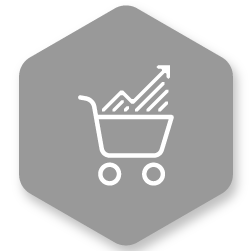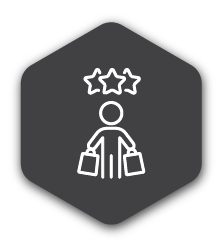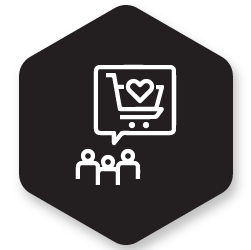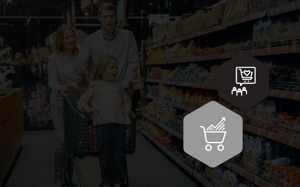The COVID-19 pandemic has lead to a major shift towards online shopping. Globally, more shoppers are buying online today versus pre-COVID. That puts more pressure on you to encourage shoppers to return to your stores. But it’s not impossible. If you want them to return, you must reconsider the type of shopping experience on offer for when your customers return.
And if you don’t? Let’s consider the statistics around online spending from a study conducted by the technology company, Bazaarvoice. Of the 5000 consumers polled, 49% indicated that they shopped more online than they did before COVID-19.
About the contributors
Jade Charters joined DotActiv in 2019 as a space planner, creating data-driven planograms for Makro, a wholesaler chain and subsidiary of Massmart that has international ties to Walmart. She currently works on the Makro General Merchandise account.
Leané Mulder joined DotActiv in 2019 as a space planner, working on various ad-hoc accounts. Since then, she has been promoted to account manager. Today, she oversees work on our Motus account.
Rina Wilkens joined DotActiv in 2018 as a space planner. She has since worked her way up to the position of account manager. Today, she oversees the Health Department at Dis-Chem, which includes categories such as Vitamins, Sports and Foods.
Suné Oosthuizen joined DotActiv in late 2019 as a space planner. She currently works on the Dis-Chem account in Johannesburg, creating data-driven planograms for the pharmacy retailer. She has a BConsumer Science Honours degree in Clothing Retail Management.

Why is the in-store experience still irreplaceable?
Think of a store that you love visiting. Even if you won’t purchase anything - those stores offer an enjoyable and even fun experience. They stand out in your mind, don’t they? The shopping experience should be more memorable than the products themselves.
Today, COVID-19 has forced our society to stay indoors. Not many people leave their homes to do their shopping if they don’t have to. That is why you need to shift your focus. If you carry on with the same approaches as pre-COVID, you most likely won’t be successful.
The in-store shopping experience is irreplaceable since it has become the determining factor for customers to return to an establishment. Do you want them to look forward to shopping in your store?
The experience that your shoppers have in your stores also determines how your customers encounter your brand, store, and products. If they enjoy interacting with your brand and products or services, they’ll likely want to return. Or, if you find ways to get the customers to stay longer in the store, they will.
Some consumers also prefer to shop in stores rather than shopping online because the instant gratification that they would get is higher and tangible. They can get an immediate sense of the quality of the item that they are purchasing and they will be able to use it immediately.
Customers can see if there are specials available, advertisements in-store and locate innovations on the shelf. It is also easier to get assistance when shopping in stores. Reaching out to a customer service agent through an online chatbot just isn’t the same as speaking directly to a store clerk, according to Caleb Opersko writing for Spot it. Returning an item due to incorrect size for example is less likely to happen. Not having to pay and wait for your item is also a bonus.
An example of one of the above could be purchasing an office chair online vs in-store. Online it looks amazing and soft and just what you want, but when it arrives it is so uncomfortable. If you had purchased it in-store, you could have tested the chair and know if it is poor quality there and then.

What can retailers do to improve the shopping experience?
1. Consider customer service levels
Every customer walking into your store wants a great customer experience. Customer services can sometimes be looked over but it is one of the most important aspects.
You can start by personalising your shopping experience. 71% of customers feel frustrated when the shopping experience is impersonal, according to Blake Morgan writing for Forbes. Customers tend to shop at stores which brands they recognise and products they know.
Make sure that all your staff members have the same mindset to uplift and improve customer services.
Each individual needs to be knowledgeable to fill gaps where they might be needed. Remember that your customers are armed with the key to endless product knowledge and reviews — the internet.
So if you let the customer wait for instance or you don’t know what to answer a question and you don’t follow up, they can give your store a serious negative review where you may lose multiple customer purchases. You should exceed the expectations of your clients to gain their customer loyalty.
2. Think about atmospherics
Atmospherics refers to the atmosphere or mood that you create in your store by way of introducing various elements and effects. You want to please your customers and give them a great experience when walking into your store. Everything from a store’s condition to its staff’s behaviour, its colours, aroma and layout play a role in customer satisfaction.
However, the atmosphere in your retail store should perform on a more subconscious level, allowing your products to take centre stage without disrupting the customer’s experience.
Keep your store clean and organized. Otherwise, you would instantly distract your customers from spending time in your store. Have staff perform routine cleaning tasks of dusting and sweeping the floors. Merchandise should be orderly and organised logically according to your retail specifications.
Lighting in the store is a very important aspect where retailers should not save. By using the correct lighting it would create the right mood in the store. Warmer, yellow, radiant lighting can be inviting and comforting to customers as it gives off a more nostalgic feel. A cooler, blue-hued light will give off a modern vibe, making customers feel alert.
Colour plays an important role in how your store is perceived, according to Nicole Martins Ferreira, who writes for Oberlo. It evokes certain emotions and perceptions in customers about goods and services. Colour psychology is also widely used in marketing and branding. It plays a major role in helping to create in-store atmospheres for purchases and customer loyalty. Dark, moody colours may not work in a store that sells baby cribs and toys. But they work perfectly for a store that sells men’s gear and fashion.
Another atmospheric factor to get your customers in the mood to spend is music. Make sure the music you play in your store fits your brand. It is an important part of your in-store experience. The type of background music you play affects how much people spend, with slower tempos encouraging people to buy more.
3. Rewards and/or Loyalty Programmes
We had a look at how we can personalise the shopper experience. Within that shopper experience, we can make use of another option, which is your customer loyalty card.
Loyalty cards are data collected from the customers that can influence how you can run your retail business. Each time the consumer swipes a loyalty card, it would give you the basic information about the consumer including what their product preferences are, how much on average the customer spends per trip to your store, their contact details and their name so that you can personally thank them for shopping at your store as soon as they leave.
According to Amanda Cromhout and Ros Netto from Truth, a 2019/20 Truth & BrandMapp survey indicated that 72% of South Africans, who are economically active, are using loyalty programmes. This is however a slight 7% decline from the previous year. This is because of the current economically unstable environment we experience.
This is a very effective mechanism to extract information about your consumers and consumers because they will only participate in a loyalty programme if they see value in it. The programme must be simple, easy to understand and provide immediate gratification.
The customer experience is also improved by a seamless process of registration, collection and redemption of rewards. By implementing a program where the consumer must be in store to redeem the rewards is an excellent booster to attract customers to your shop.
For example, a recent booster to attract customers is a branded pan sold at a 75% discount in a particular convenience store. To redeem this discount, you must collect 20 stickers for every dollar or rand that you spend in the store.

What category management actions improve the shopping experience?
1. You can implement clustering
Through clustering, you identify consumer similarities between stores, which enables you to cluster these stores together within a cluster. The stores within a cluster receive a similar range of products which ensures that the target market of that specific cluster receives the right product offering to satisfy their needs. Clustering allows your stores to hold a specific product assortment based on the store's profile (i.e. geographic location, LSM).
For example, stores based in a low LSM, rural area will need to cater for smaller and cheaper purchases. By optimising your cluster, you can cater to your customers' needs, allowing them to always find their preferred products.
Clustering is also beneficial in terms of ensuring consistency across stores. If your “look & feel” is consistent throughout all the stores, your consumers will feel comfortable shopping in your store.
They can go to any of your stores and get what they want because they are familiar with the layout. It will ultimately result in consumers trusting you as they can easily find the products that they are looking for and move through the store with the same ease and without any frustration. This leads to a positive in-store shopping experience for the consumer.
There are, however, consequences if you do not implement clustering within your store. For example, not focusing on the right categories of demographics will cause customers to only make necessary purchases and not browse through the store. You could also end up cutting products from your range that your consumers specifically came to your store for.
You may also waste a lot of space on the shelves by keeping products that are not performing in the store or having a lack of space to stock the products that your customers prefer.
2. You can implement assortment plans
Assortment plans are essential when looking at the broader picture of in-store shopping experiences and how to continuously meet the demands of your consumers. You can create custom data-driven product assortments that meet local shoppers’ needs and drive profitability in-store. Customers love to look at aisles that are neat and organised, where products are not all over the place.
Assortment planning creates flows that make it easier to find products on the shelf. By doing assortment planning, you can place products in certain areas in the store for a reason. It might be due to an occasion, season or more. So that both you and the customers gain from the outcome.
When creating assortment plans, it is essential to analyse the consumer preferences within your clusters and also to take into consideration the type of consumer you are targeting. What are their needs? What does their spending behaviour look like? What profile of the brands do they buy?
All these factors influence the ranges that you create and will ensure your consumers have options in-store that apply to their needs and wants. This will allow you to deliver the right products to the right people and avoid excess inventory and missed sales opportunities through out of stocks.
It doesn’t make sense to stock super-premium products in a Low LSM demographic store, since no one will buy the products because they are too expensive. Assortment planning will allow you to stock a specific product based on the store's profile and store size (i.e. geographic location, LSM, small store).
3. You can implement planograms
You can use planograms to improve the shopping experiences of consumers. Planograms allow you to create a visually appealing store with organised shelves and aisles that will create a positive shopping experience.
With a logical flow, it’s easier to find the products that you are looking for. The entire range that applies to that specific store would be available. When building planograms, you can use set merchandising principles and apply your consumer decision tree (CDT) to the merchandising flow.
Doing so allows you to identify the top brands and allocate more space and/or better placement on the shelf. This will improve customer satisfaction and will lead to an enjoyable in-store experience, which encourages them to return.
When you are merchandising the products according to all these factors, it will also ensure that consumers buy more impulsively. This increases their basket sizes, which ultimately increases your sales and profits.
When you are not using data-driven planograms it will result in the opposite as above. It can lead to brands that are not allocated to their deserving spaces on the shelf. That results in your customers struggling to find what they are looking for.
If, for example, you are a pharmacy retailer and you do not make use of data to merchandise your categories, you might find your Nutrition food section next to the Bath care section. Or you might give one category too much space. You might have given the nutritious food two drops which are not enough, while the Bath care section receives six drops, which it doesn’t need or deserve.
If it is not easy to navigate through departments to find the products that you are looking for. It will ultimately negatively influence the shopping experience. This can lead to consumers avoiding in-store shopping. Having a chaotic store can confuse anyone. You might also not implement any proper stock rotation because you don’t monitor your stock properly. Also, overstocking or gaps on the shelves can give your store an untidy look.
4. You can implement floor plans
A well-built floor plan can help you create the optimal store layout that will ensure an even distribution of high traffic and low traffic throughout your store. The consumer should easily navigate between departments and find all the products that they are looking for.
Floor plans also help to direct any traffic flow to avoid build-ups in certain areas. It also assists with optimising the floorspace to ensure optimal revenue can be received. This will lead to a positive shopping experience since shoppers will know where to find the products they desire. It will be easy to navigate to the desired aisle.
Floor Planning is where all the other functions of category management come together. It allows you to plan your store on a macro level. You can complete space allocations based on entire department contributions, right down to a category level. This allows each department and category to receive adequate space based on their performance.
A consequence of not using data-driven floor plans is that space allocations will be unequal and complimentary categories will be split across the store. That doesn’t make for a pleasant shopping experience and it can lead to consumers avoiding your store and rather shopping at your direct competitor or online.
Giving more space to a department that does not generate a lot of sales to the store, over another department that does generate most of the store sales is also very harmful to your business. If a data-driven floor plan was implemented from the start this problem would not have occurred and it would be clear which department warrants the most space which will, in turn, generate more sales.
Conclusion
Today, COVID-19 has forced us to stay indoors. Not many people leave their homes to do their shopping and when they do, they don’t stay in-store for longer than they need to. That is why you need to shift your focus onto creating an experience that’ll encourage them to visit.
Do you need help setting up such experiences? You can book a complimentary custom exploratory consultation with us here or visit our online store.


